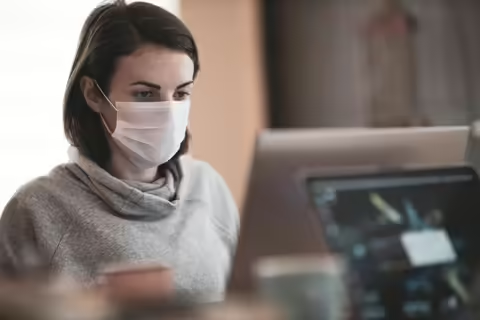URBANA, Ill. – During the COVID-19 pandemic, many are paying closer attention to numbers than ever before. Whether it’s the number of new cases in local communities or the death toll worldwide, these figures can be alarming and overwhelming.
Enter Zaheeda Darvesh. The data analyst with University of Illinois Extension is taming COVID-19 numbers for one Illinois community and helping the public make sense of the crisis.
Darvesh built and maintains the interactive dashboard for Champaign Urbana’s Public Health District (CUPHD). The clean graphical interface serves Champaign County’s COVID-19 numbers in an easily digestible format, eliminating confusion and minimizing effort for a public in search of answers. And that’s powerful.
“The dashboard, as simple as it is, allows the public to grasp the data in a very simple manner," Darvesh says. "It gives just the right amount of information without looking daunting and cumbersome.”
Epidemiologist and deputy CUPHD administrator Awais Vaid adds, “A clean and interactive dashboard is very informative for data sharing. We have always been very transparent with our data sharing, and we also try to be timely with sharing as well. Having the option to update the data daily with the most current information is very helpful. We have media outlets, local partners, and the general community patiently waiting daily for updates.”
The dashboard led to some “ah-ha moments” for CUPHD, according to Vaid. For example, daily changes in the interactive map give the district and community members a better grasp of how the virus is moving. And, a mobility indicator provides a measure of how well Champaign County residents are complying with the stay-at-home order compared with the rest of the state.
“We are visiting parks a lot more than the average in Illinois," Vaid says. "Hopefully we are doing it safely.”
Darvesh and CUPHD administrators made several tweaks to the tool in response to demand from the community, most recently adding a tally of the number of tests performed.
Being of service and responding to community needs is not new for Darvesh, part of the Family and Consumer Sciences team for Illinois Extension. The team delivers educational programming related to SNAP benefits (food stamps), family nutrition, and more in communities across Illinois, particularly in vulnerable populations.
“What we do really well is provide the community with resources and serve as a community connector," says Jennifer McCaffrey, assistant dean for Family and Consumer Sciences with Illinois Extension. "Often it's breaking down research-based data into consumer-friendly pieces that help people change their lives. We rely on Zaheeda to break down health data that not only informs what we do in Extension, but also so the community at large can use that health data in their own decision making.”
Public health districts across the state have long partnered with Extension to help individuals access food and resources through food pantries, summer food programs, and much more. And right now, many public health offices are making use of and sharing Extension’s ready-made COVID-19 resources.
“For example, we’re seeing a lot of the health departments across the state sharing our materials on making your own bleach sanitizer, and sharing our resources on social media, their websites, or newsletters,” McCaffrey says. “Others are sharing our recipes and using our nutrition information to help people, especially those enrolled in the SNAP or WIC programs, extend their food dollars.”
Darvesh typically applies her analysis and visualization skills to show the impact of Extension’s programming on a state level, but a personal connection to CUPHD made the local project a good fit.
“I was a past employee at CUPHD. Friends of Champaign County Food pantry, the local Muslim food pantry for whom Extension provides programming, is also located at the health district,” she says. “Based on these past experiences, I’ve developed close relationships with the health district, and they are a valued local community partner. I saw the previous iteration of the website and proposed an option that would entail a highly interactive visualization to reflect COVID data, and the health district agreed.
“But really, this is what our staff and administrators do all along: assist local communities, residents, and partners, in times of need and adversity. So when the opportunity presented itself, I was very excited to see our experience at Extension’s Family and Consumer Science division being put to use for a community partner. It is a way of showcasing that Extension assistance can come in various ways, forms, and products,” Darvesh says.
Source: Zaheeda Darvesh
Source: Jennifer McCaffrey
News writer: Lauren Quinn, 217-300-2435, ldquinn@illinois.edu
